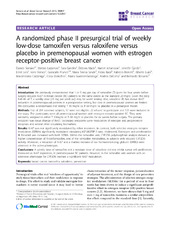A randomized phase II pre-surgical trial of weekly low-dose tamoxifen versus raloxifene versus placebo in premenopausal women with estrogen receptor positive breast cancer
Serrano, Davide; Lazzeroni, Matteo; Gandini, Sara; Macis, Debora; Johansson, Harriet; Gjerde, Jennifer; Lien, Ernst Asbjørn; Feroce, Irene; Pruneri, Giancarlo; Sandri, Maria Teresa; Bassi, Fabio; Brenelli, Fabricio; Luini, Alberto; Cazzaniga, Massimiliano; Varricchio, Clara; Guerrieri-Gonzaga, Aliana; DeCensi, Andrea; Bonanni, Bernardo
Peer reviewed, Journal article
Published version
Permanent lenke
https://hdl.handle.net/1956/8513Utgivelsesdato
2013-06-20Metadata
Vis full innførselSamlinger
Originalversjon
https://doi.org/10.1186/bcr3439Sammendrag
Introduction: We previously demonstrated that 1 or 5 mg per day of tamoxifen (T) given for four weeks before surgery reduces Ki-67 in breast cancer (BC) patients to the same extent as the standard 20 mg/d. Given the long half-life of T, a weekly dose (10 mg per week (w)) may be worth testing. Also, raloxifene (R) has shown Ki-67 reduction in postmenopausal patients in a preoperative setting, but data in premenopausal women are limited. We conducted a randomized trial testing T 10 mg/w vs. R 60 mg/d vs. placebo in a presurgical model. Methods: Out of 204 screened subjects, 57 were not eligible, 22 refused to participate and 125 were included in the study. The participants were all premenopausal women with estrogen receptor-positive BC. They were randomly assigned to either T 10mg/w or R 60 mg/d or placebo for six weeks before surgery. The primary endpoint was tissue change of Ki-67. Secondary endpoints were modulation of estrogen and progesterone receptors and several other circulating biomarkers. Results: Ki-67 was not significantly modulated by either treatment. In contrast, both selective estrogen receptor modulators (SERMs) significantly modulated circulating IGF-I/IGFBP-3 ratio, cholesterol, fibrinogen and antithrombin III. Estradiol was increased with both SERMs. Within the tamoxifen arm, CYP2D6 polymorphism analysis showed a higher concentration of N-desTamoxifen, one of the tamoxifen metabolites, in subjects with reduced CYP2D6 activity. Moreover, a reduction of Ki-67 and a marked increase of sex hormone-binding globulin (SHBG) were observed in the active phenotype. Conclusions: A weekly dose of tamoxifen and a standard dose of raloxifene did not inhibit tumor cell proliferation, measured as Ki-67 expression, in premenopausal BC patients. However, in the tamoxifen arm women with an extensive phenotype for CYP2D6 reached a significant Ki-67 modulation.
Utgiver
BioMed CentralTidsskrift
Breast Cancer ResearchOpphavsrett
Davide Serrano et al.; licensee BioMed Central Ltd.Copyright 2013 Serrano et al.; licensee BioMed Central Ltd.

